2022届高考英语二轮复习:形容词和副词的用法课件(45张)
文档属性
| 名称 | 2022届高考英语二轮复习:形容词和副词的用法课件(45张) |  | |
| 格式 | pptx | ||
| 文件大小 | 335.2KB | ||
| 资源类型 | 教案 | ||
| 版本资源 | 通用版 | ||
| 科目 | 英语 | ||
| 更新时间 | 2022-05-03 08:37:47 | ||
图片预览


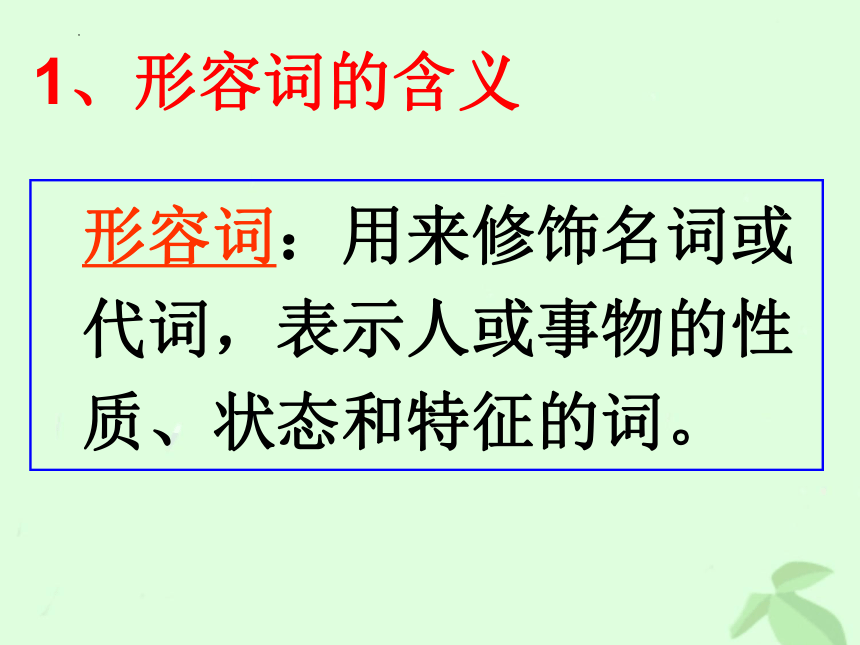
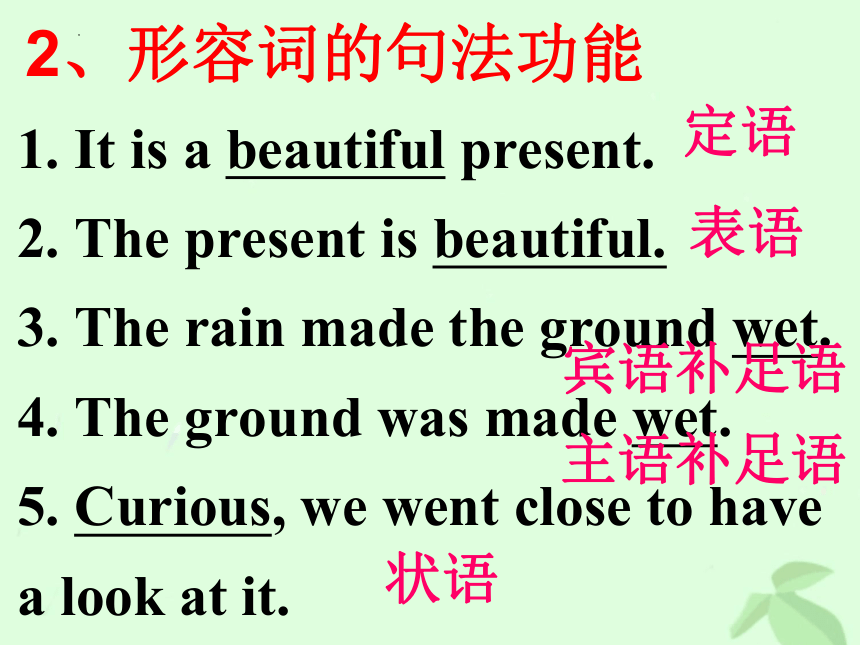

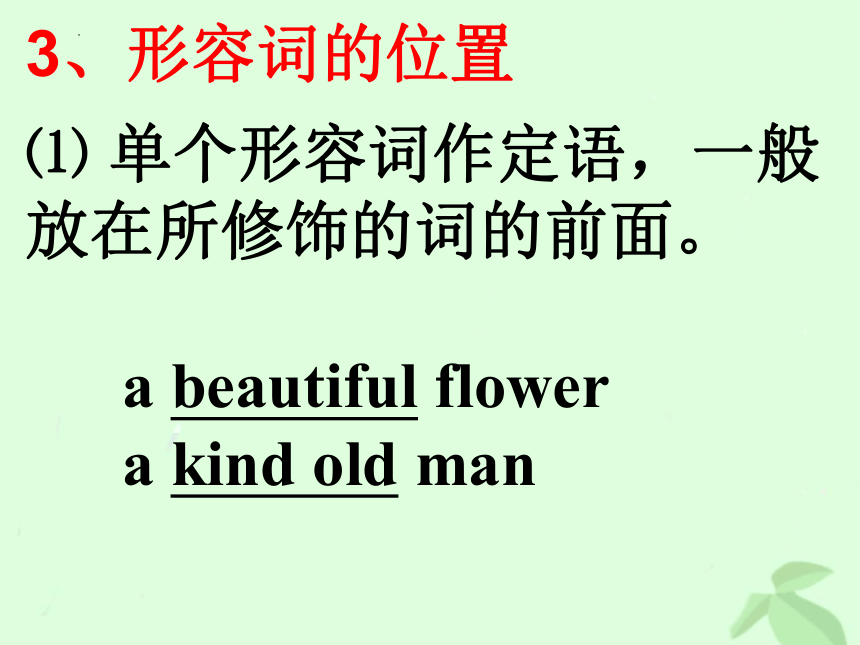
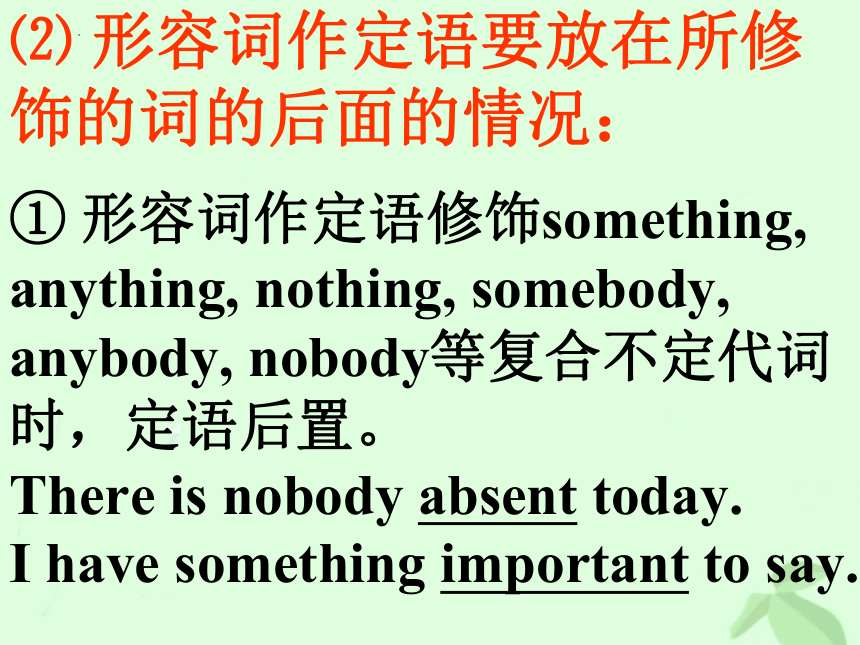
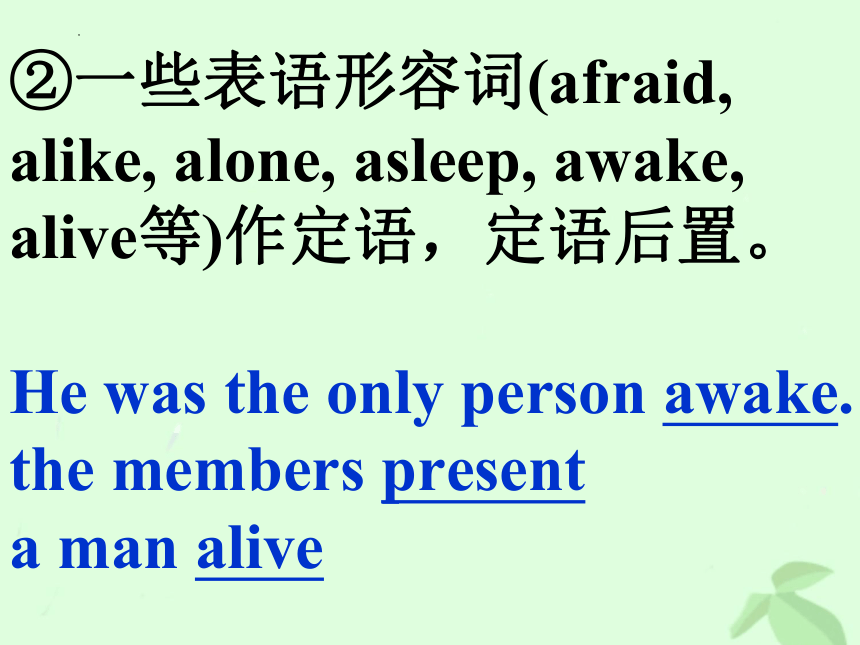
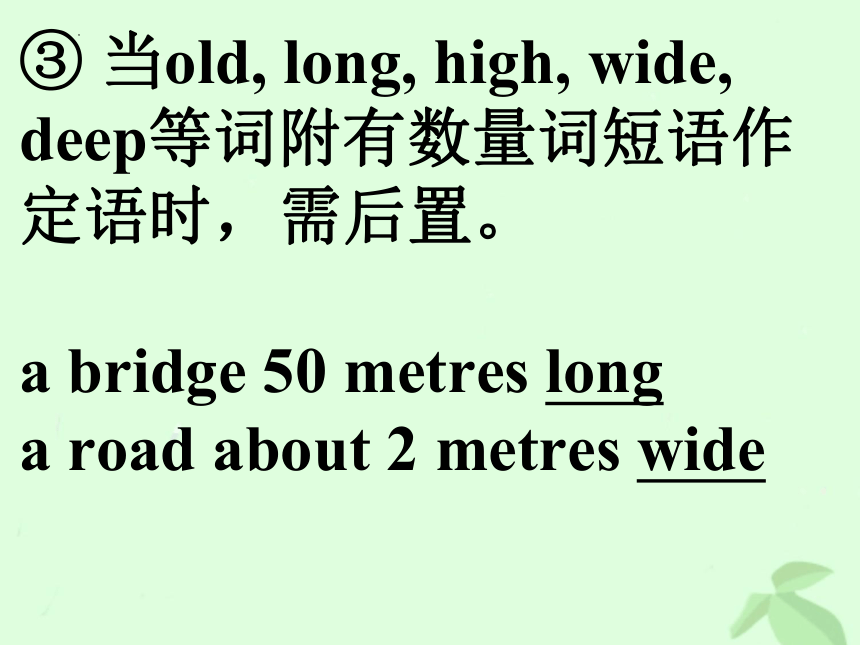
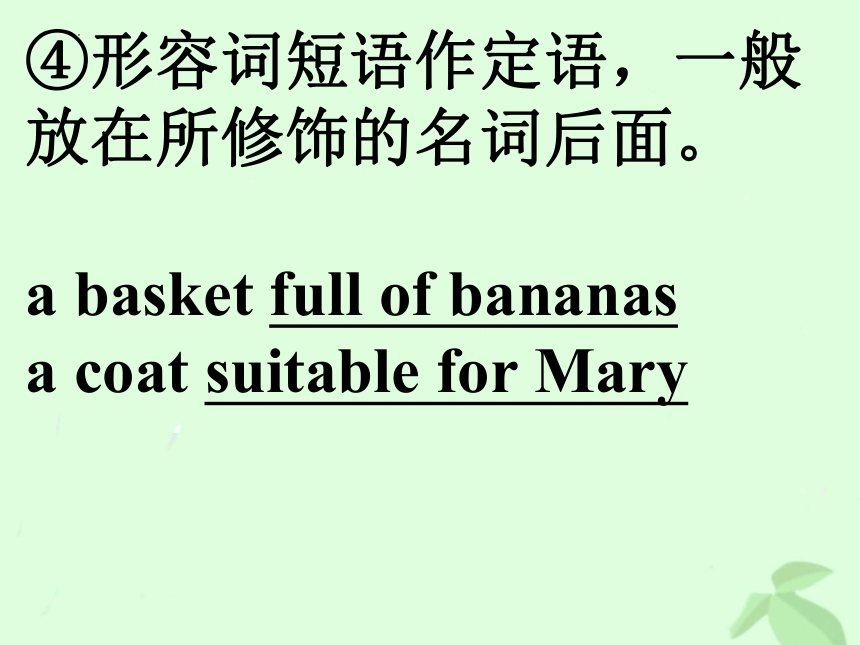
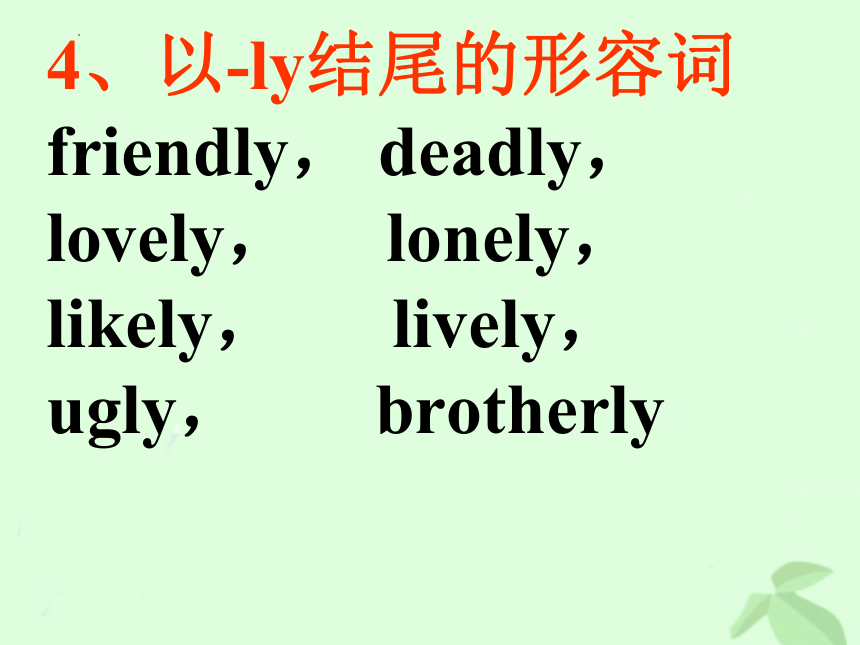
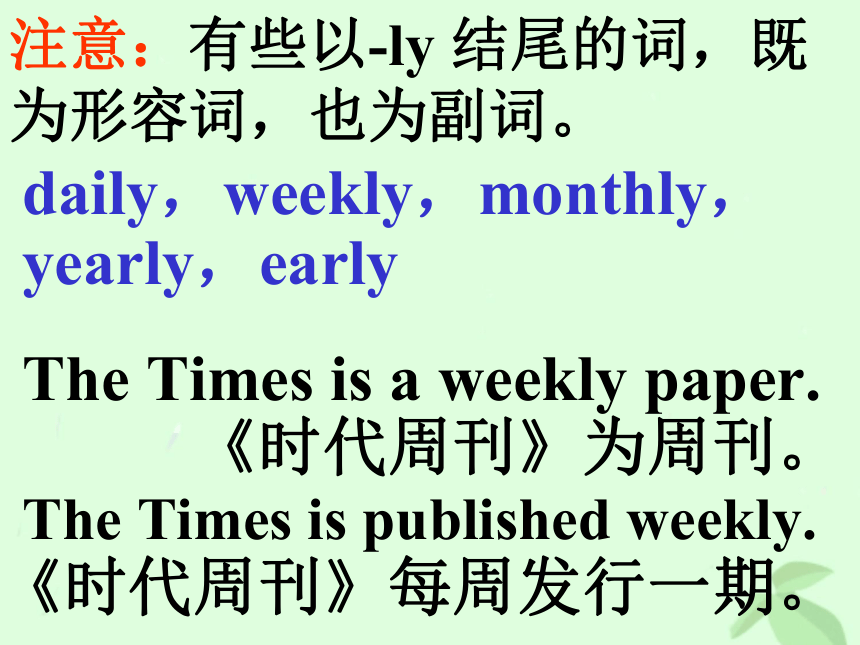
文档简介
(共45张PPT)
adj. & adv.
形容词和副词
形容词的用法及位置
形容词:用来修饰名词或代词,表示人或事物的性质、状态和特征的词。
1、形容词的含义
2、形容词的句法功能
1. It is a beautiful present.
2. The present is beautiful.
3. The rain made the ground wet.
4. The ground was made wet.
5. Curious, we went close to have a look at it.
定语
表语
宾语补足语
主语补足语
状语
注意:形容词作状语表示伴随或结果,并不表示动作的方式。
He returned home, safe and sound.(安然无恙)
3、形容词的位置
⑴ 单个形容词作定语,一般放在所修饰的词的前面。
a beautiful flower
a kind old man
⑵ 形容词作定语要放在所修饰的词的后面的情况:
① 形容词作定语修饰something, anything, nothing, somebody, anybody, nobody等复合不定代词时,定语后置。
There is nobody absent today.
I have something important to say.
②一些表语形容词(afraid, alike, alone, asleep, awake, alive等)作定语,定语后置。
He was the only person awake.
the members present
a man alive
③ 当old, long, high, wide, deep等词附有数量词短语作定语时,需后置。
a bridge 50 metres long
a road about 2 metres wide
④形容词短语作定语,一般放在所修饰的名词后面。
a basket full of bananas
a coat suitable for Mary
4、以-ly结尾的形容词
friendly, deadly,lovely, lonely,
likely, lively,
ugly, brotherly
注意:有些以-ly 结尾的词,既为形容词,也为副词。
daily,weekly,monthly,yearly,early
The Times is a weekly paper.
《时代周刊》为周刊。
The Times is published weekly.
《时代周刊》每周发行一期。
5、用形容词表示类别和整体
1)某些形容词加上定冠词,泛指一类人,谓语动词用复数
the dead, the living
the rich, the poor
the blind, the hungry
2) 有关国家和民族的形容词加上定冠词指这个民族的整体,与动词的复数连用。
the British,the English,
the French,the Chinese
The English have wonderful sense of humor.
6、分词作形容词
现在分词: interesting
encouraging, exciting
过去分词: interested
encouraged, excited
副词的用法及位置
副词:用来修饰动词、形容词、其它副词或整个句子,说明时间、地点、程度、方式等概念的词。
1、副词的含义
1. 时间副词:often, always, soon usually, early, now, frequently,
2. 地点副词:here, there, home,
outside, below, back
3. 方式副词: quickly, slowly, fast
hard, warmly, angrily
4. 程度副词:very, quite, much,
too, enough, rather, greatly
2、副词的分类
5. 疑问副词:where, how
when,why
6. 连接副词:how, when
where, why
7. 关系副词:when, why,
where
8. 评价性副词:fortunately,
luckily, personally
3、副词的句法功能
1. Is he content with the life here
2. All the lights are on.
3. Please let him in.
4. He was shown around by Jim.
5. Actually, he is right.
6. You are quite right.
定语
表语
宾语补足语
主语补足语
状语
状语
4、副词的构成
⑴大多数是由形容词后缀-ly构成
①以 –le结尾时,去掉e再加y
simple – simply
terrible – terribly
② busy – busily
heavy – heavily
happy – happily
③ 以-ll结尾时,只须加y
full – fully dull – dully
④ 以-ic结尾时,加-ally
economic – economically
basic – basically
⑵有些副词由介词或地点名词加后缀-ward(s)构成,“向……”
backward backwards
downward downwards
westward westwards
upward upwards
⑶ 有些副词与形容词同形
early long
straight fast
hard well
⑷ 有些副词有两种形式,一个与形容词同形,一个以-ly结尾,含义不同。
表原意(无 ly) ,引申意(有 ly)
most
near
hard
mostly
nearly
hardly
非常,最
主要地
邻近
几乎
努力地
几乎不
5、副词的位置
⑴ 单个副词修饰形容词和副词时,一般放在被修饰的词之前。It is a very easy job.
He runs very fast.
特殊:enough
He didn’t work hard enough.
He is not old enough.
⑵ 修饰全句的副词,一般位于句首。
Truly, he is an honest man.
Luckily, he passed the exam.
⑶表示时间频度的副词, just, always, often, usually, seldom, rarely, never, still, already等,常放在行为动词前,情态动词、助动词或系动词之后。
He often comes to see me.
The shop is still open.
She will always be remembered.
We should always study hard.
形容词、副词
比较等级的用法
使用比较级、最高级时应注意的问题
⑴比较级前常可用still, even, much, far, a lot / little / few / bit, rather, any, a great deal, so far, by far, no等词修饰。
⑵ 最高级可被序数词以及by far, nearly, almost, by no means, not quite, not really, nothing like等词语所修饰。
the second longest river
It is by far the longest.
This hat is by no means the biggest.
⑸ 比较级的常用句型
① not+比较级+than
no+比较级+than
表示所比较的两种事物都具有与形容词或副词相反的意义,“A和B都不”
表示所比较的两者中,前者不如后者
He is not poorer than his elder sister.
He is no poorer than his sister.
他没有他的姐姐那么贫困。(姐姐更贫困)
他和姐姐都不贫困(一样富有)。
② no more than
not more than
“仅仅,只”,有嫌少之意
“不超过,至多……”
是一种客观叙述。
③ no less than
not less than
“居然有,竟然有,多达,不下于……”,表示惊奇,相当于as much/ many as
“不少于,至少……”
是一种客观叙述。
④ not so much A as B
more A than B
“与其说是A,不如说是B”
“与其说是B,不如说是A”
* Jim is not so much a writer as a teacher.
* Jim is more a writer than a teacher.
⑤ can’t … too + adj./adv.
无论……都不为过
You can never be too careful.
⑥ the +比较级, the+比较级
越……越……
The more careful you are, the fewer mistakes you’ll make.
⑦比较级+and+比较级
“越来越……”
It is getting cooler and cooler.
He is becoming more and more active.
⑧ “否定式谓语+比较级”
表示最高级含义
* Your story is perfect; I’ve never heard _______ before.
A. the better one B. the best one
C. a better one D. a good one
(9) 最高级前不带the的情况
① 形容词最高级前一般要加the,但当形容词用作表语而又不是和别人进行比较时,常不带the。
He is busiest on Tuesday.
② 形容词最高级前已有物主代词或名词所有格修饰时,不用the。
* Mary is my best friend.
* Tom’s greatest wish is to become an engineer.
③ 两个形容词最高级同时修饰一个名词,后一个最高级前不用the。
He is the weakest but best student in our class.
④ most “大多数的”
Most people enjoy sports.
most “非常”
It is most beautiful.
It’s a most interesting book.
⑤ 最高级形容词用在由as引导的倒装的让步状语从句时,不用the
Oldest in our factory as he is he works hardest.
adj. & adv.
形容词和副词
形容词的用法及位置
形容词:用来修饰名词或代词,表示人或事物的性质、状态和特征的词。
1、形容词的含义
2、形容词的句法功能
1. It is a beautiful present.
2. The present is beautiful.
3. The rain made the ground wet.
4. The ground was made wet.
5. Curious, we went close to have a look at it.
定语
表语
宾语补足语
主语补足语
状语
注意:形容词作状语表示伴随或结果,并不表示动作的方式。
He returned home, safe and sound.(安然无恙)
3、形容词的位置
⑴ 单个形容词作定语,一般放在所修饰的词的前面。
a beautiful flower
a kind old man
⑵ 形容词作定语要放在所修饰的词的后面的情况:
① 形容词作定语修饰something, anything, nothing, somebody, anybody, nobody等复合不定代词时,定语后置。
There is nobody absent today.
I have something important to say.
②一些表语形容词(afraid, alike, alone, asleep, awake, alive等)作定语,定语后置。
He was the only person awake.
the members present
a man alive
③ 当old, long, high, wide, deep等词附有数量词短语作定语时,需后置。
a bridge 50 metres long
a road about 2 metres wide
④形容词短语作定语,一般放在所修饰的名词后面。
a basket full of bananas
a coat suitable for Mary
4、以-ly结尾的形容词
friendly, deadly,lovely, lonely,
likely, lively,
ugly, brotherly
注意:有些以-ly 结尾的词,既为形容词,也为副词。
daily,weekly,monthly,yearly,early
The Times is a weekly paper.
《时代周刊》为周刊。
The Times is published weekly.
《时代周刊》每周发行一期。
5、用形容词表示类别和整体
1)某些形容词加上定冠词,泛指一类人,谓语动词用复数
the dead, the living
the rich, the poor
the blind, the hungry
2) 有关国家和民族的形容词加上定冠词指这个民族的整体,与动词的复数连用。
the British,the English,
the French,the Chinese
The English have wonderful sense of humor.
6、分词作形容词
现在分词: interesting
encouraging, exciting
过去分词: interested
encouraged, excited
副词的用法及位置
副词:用来修饰动词、形容词、其它副词或整个句子,说明时间、地点、程度、方式等概念的词。
1、副词的含义
1. 时间副词:often, always, soon usually, early, now, frequently,
2. 地点副词:here, there, home,
outside, below, back
3. 方式副词: quickly, slowly, fast
hard, warmly, angrily
4. 程度副词:very, quite, much,
too, enough, rather, greatly
2、副词的分类
5. 疑问副词:where, how
when,why
6. 连接副词:how, when
where, why
7. 关系副词:when, why,
where
8. 评价性副词:fortunately,
luckily, personally
3、副词的句法功能
1. Is he content with the life here
2. All the lights are on.
3. Please let him in.
4. He was shown around by Jim.
5. Actually, he is right.
6. You are quite right.
定语
表语
宾语补足语
主语补足语
状语
状语
4、副词的构成
⑴大多数是由形容词后缀-ly构成
①以 –le结尾时,去掉e再加y
simple – simply
terrible – terribly
② busy – busily
heavy – heavily
happy – happily
③ 以-ll结尾时,只须加y
full – fully dull – dully
④ 以-ic结尾时,加-ally
economic – economically
basic – basically
⑵有些副词由介词或地点名词加后缀-ward(s)构成,“向……”
backward backwards
downward downwards
westward westwards
upward upwards
⑶ 有些副词与形容词同形
early long
straight fast
hard well
⑷ 有些副词有两种形式,一个与形容词同形,一个以-ly结尾,含义不同。
表原意(无 ly) ,引申意(有 ly)
most
near
hard
mostly
nearly
hardly
非常,最
主要地
邻近
几乎
努力地
几乎不
5、副词的位置
⑴ 单个副词修饰形容词和副词时,一般放在被修饰的词之前。It is a very easy job.
He runs very fast.
特殊:enough
He didn’t work hard enough.
He is not old enough.
⑵ 修饰全句的副词,一般位于句首。
Truly, he is an honest man.
Luckily, he passed the exam.
⑶表示时间频度的副词, just, always, often, usually, seldom, rarely, never, still, already等,常放在行为动词前,情态动词、助动词或系动词之后。
He often comes to see me.
The shop is still open.
She will always be remembered.
We should always study hard.
形容词、副词
比较等级的用法
使用比较级、最高级时应注意的问题
⑴比较级前常可用still, even, much, far, a lot / little / few / bit, rather, any, a great deal, so far, by far, no等词修饰。
⑵ 最高级可被序数词以及by far, nearly, almost, by no means, not quite, not really, nothing like等词语所修饰。
the second longest river
It is by far the longest.
This hat is by no means the biggest.
⑸ 比较级的常用句型
① not+比较级+than
no+比较级+than
表示所比较的两种事物都具有与形容词或副词相反的意义,“A和B都不”
表示所比较的两者中,前者不如后者
He is not poorer than his elder sister.
He is no poorer than his sister.
他没有他的姐姐那么贫困。(姐姐更贫困)
他和姐姐都不贫困(一样富有)。
② no more than
not more than
“仅仅,只”,有嫌少之意
“不超过,至多……”
是一种客观叙述。
③ no less than
not less than
“居然有,竟然有,多达,不下于……”,表示惊奇,相当于as much/ many as
“不少于,至少……”
是一种客观叙述。
④ not so much A as B
more A than B
“与其说是A,不如说是B”
“与其说是B,不如说是A”
* Jim is not so much a writer as a teacher.
* Jim is more a writer than a teacher.
⑤ can’t … too + adj./adv.
无论……都不为过
You can never be too careful.
⑥ the +比较级, the+比较级
越……越……
The more careful you are, the fewer mistakes you’ll make.
⑦比较级+and+比较级
“越来越……”
It is getting cooler and cooler.
He is becoming more and more active.
⑧ “否定式谓语+比较级”
表示最高级含义
* Your story is perfect; I’ve never heard _______ before.
A. the better one B. the best one
C. a better one D. a good one
(9) 最高级前不带the的情况
① 形容词最高级前一般要加the,但当形容词用作表语而又不是和别人进行比较时,常不带the。
He is busiest on Tuesday.
② 形容词最高级前已有物主代词或名词所有格修饰时,不用the。
* Mary is my best friend.
* Tom’s greatest wish is to become an engineer.
③ 两个形容词最高级同时修饰一个名词,后一个最高级前不用the。
He is the weakest but best student in our class.
④ most “大多数的”
Most people enjoy sports.
most “非常”
It is most beautiful.
It’s a most interesting book.
⑤ 最高级形容词用在由as引导的倒装的让步状语从句时,不用the
Oldest in our factory as he is he works hardest.
